Evidence for Practice Essay: Nursing Practice and Clinical Risk
VerifiedAdded on 2023/02/03
|9
|2541
|25
Essay
AI Summary
This essay provides a comprehensive analysis of a clinical risk management policy within a healthcare setting, specifically focusing on its implications for nursing practice. The introduction establishes the significance of policies in organizations and their role in guiding procedures. The essay then delves into the chosen policy: clinical risk management, detailing its principles, components, and importance in ensuring patient safety and quality care. It examines how nurses are central to this policy, responsible for identifying, assessing, and mitigating risks, with training and supervision being essential for effective implementation. The essay draws on evidence to show how clinical risk management reduces accidents, minimizes costs, and improves public perception, while also highlighting the importance of professional development and self-assessment for nurses. Furthermore, the essay discusses the application of this policy in hospitals, the systematic processes involved, and the emphasis on early risk detection and continuous improvement. The conclusion reiterates the policy's pivotal role in healthcare, emphasizing its impact on minimizing risks and promoting a safe environment for both patients and healthcare professionals. The essay also references various books and journals to support the arguments made.
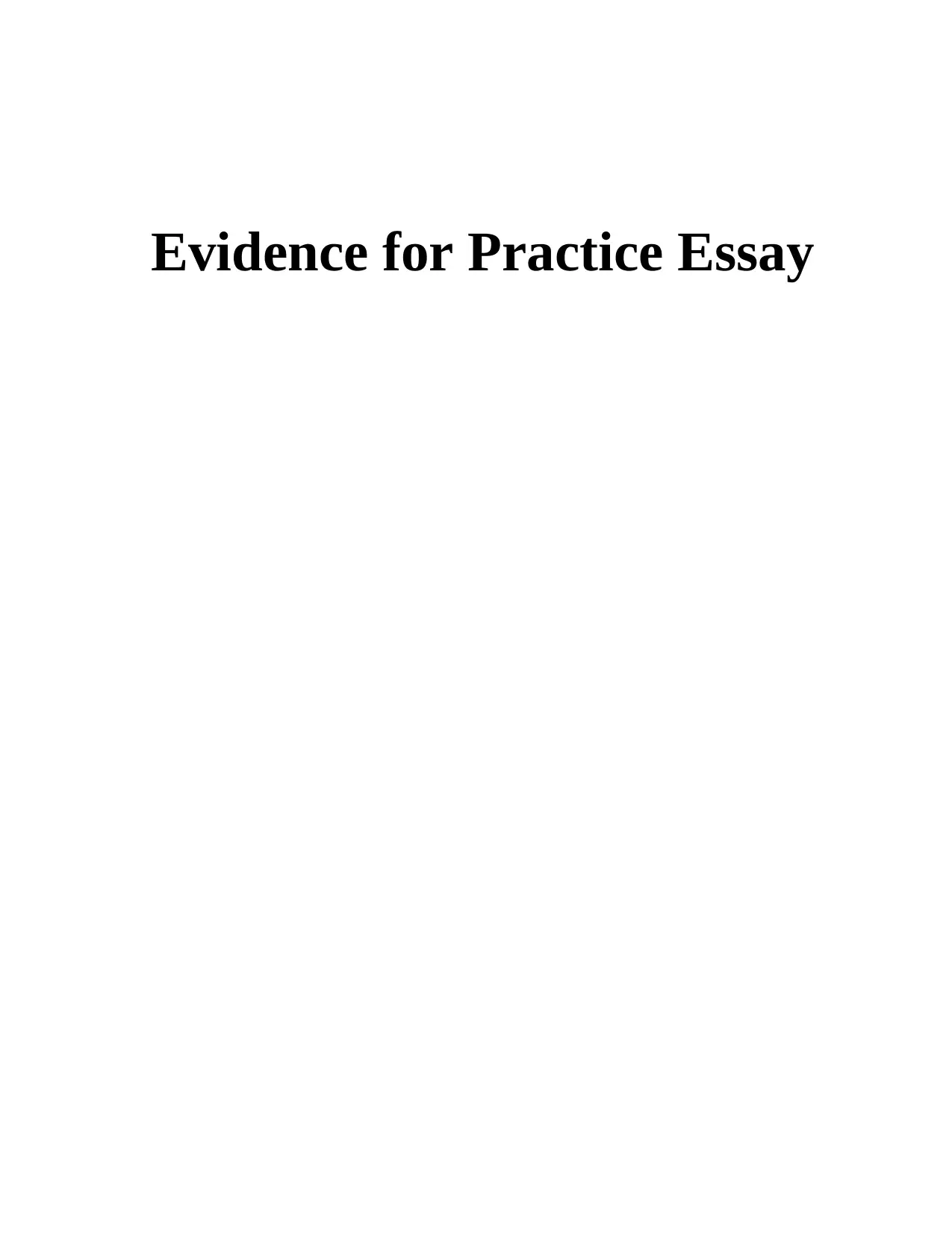
Evidence for Practice Essay
Paraphrase This Document
Need a fresh take? Get an instant paraphrase of this document with our AI Paraphraser
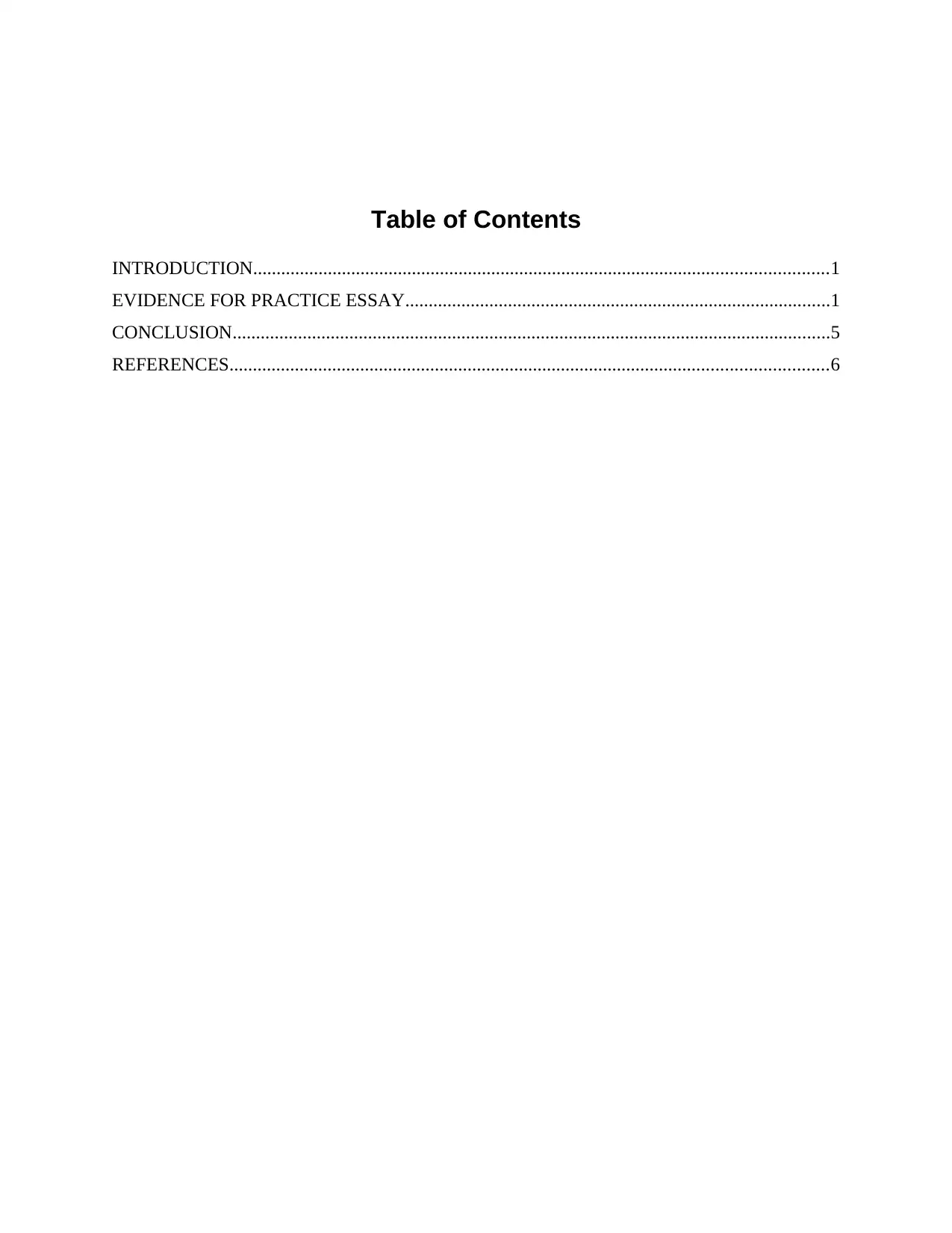
Table of Contents
INTRODUCTION...........................................................................................................................1
EVIDENCE FOR PRACTICE ESSAY...........................................................................................1
CONCLUSION................................................................................................................................5
REFERENCES................................................................................................................................6
INTRODUCTION...........................................................................................................................1
EVIDENCE FOR PRACTICE ESSAY...........................................................................................1
CONCLUSION................................................................................................................................5
REFERENCES................................................................................................................................6
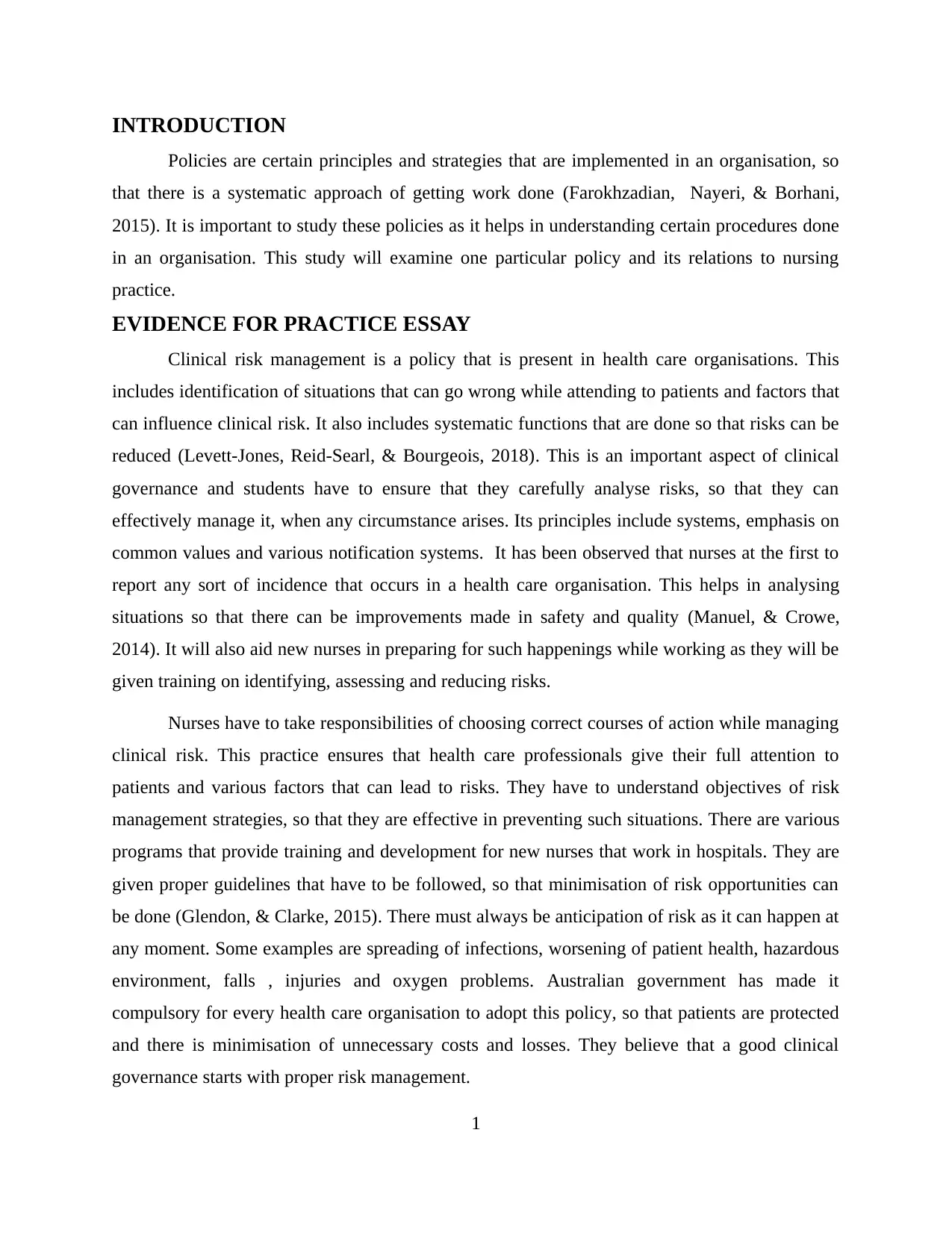
INTRODUCTION
Policies are certain principles and strategies that are implemented in an organisation, so
that there is a systematic approach of getting work done (Farokhzadian, Nayeri, & Borhani,
2015). It is important to study these policies as it helps in understanding certain procedures done
in an organisation. This study will examine one particular policy and its relations to nursing
practice.
EVIDENCE FOR PRACTICE ESSAY
Clinical risk management is a policy that is present in health care organisations. This
includes identification of situations that can go wrong while attending to patients and factors that
can influence clinical risk. It also includes systematic functions that are done so that risks can be
reduced (Levett-Jones, Reid-Searl, & Bourgeois, 2018). This is an important aspect of clinical
governance and students have to ensure that they carefully analyse risks, so that they can
effectively manage it, when any circumstance arises. Its principles include systems, emphasis on
common values and various notification systems. It has been observed that nurses at the first to
report any sort of incidence that occurs in a health care organisation. This helps in analysing
situations so that there can be improvements made in safety and quality (Manuel, & Crowe,
2014). It will also aid new nurses in preparing for such happenings while working as they will be
given training on identifying, assessing and reducing risks.
Nurses have to take responsibilities of choosing correct courses of action while managing
clinical risk. This practice ensures that health care professionals give their full attention to
patients and various factors that can lead to risks. They have to understand objectives of risk
management strategies, so that they are effective in preventing such situations. There are various
programs that provide training and development for new nurses that work in hospitals. They are
given proper guidelines that have to be followed, so that minimisation of risk opportunities can
be done (Glendon, & Clarke, 2015). There must always be anticipation of risk as it can happen at
any moment. Some examples are spreading of infections, worsening of patient health, hazardous
environment, falls , injuries and oxygen problems. Australian government has made it
compulsory for every health care organisation to adopt this policy, so that patients are protected
and there is minimisation of unnecessary costs and losses. They believe that a good clinical
governance starts with proper risk management.
1
Policies are certain principles and strategies that are implemented in an organisation, so
that there is a systematic approach of getting work done (Farokhzadian, Nayeri, & Borhani,
2015). It is important to study these policies as it helps in understanding certain procedures done
in an organisation. This study will examine one particular policy and its relations to nursing
practice.
EVIDENCE FOR PRACTICE ESSAY
Clinical risk management is a policy that is present in health care organisations. This
includes identification of situations that can go wrong while attending to patients and factors that
can influence clinical risk. It also includes systematic functions that are done so that risks can be
reduced (Levett-Jones, Reid-Searl, & Bourgeois, 2018). This is an important aspect of clinical
governance and students have to ensure that they carefully analyse risks, so that they can
effectively manage it, when any circumstance arises. Its principles include systems, emphasis on
common values and various notification systems. It has been observed that nurses at the first to
report any sort of incidence that occurs in a health care organisation. This helps in analysing
situations so that there can be improvements made in safety and quality (Manuel, & Crowe,
2014). It will also aid new nurses in preparing for such happenings while working as they will be
given training on identifying, assessing and reducing risks.
Nurses have to take responsibilities of choosing correct courses of action while managing
clinical risk. This practice ensures that health care professionals give their full attention to
patients and various factors that can lead to risks. They have to understand objectives of risk
management strategies, so that they are effective in preventing such situations. There are various
programs that provide training and development for new nurses that work in hospitals. They are
given proper guidelines that have to be followed, so that minimisation of risk opportunities can
be done (Glendon, & Clarke, 2015). There must always be anticipation of risk as it can happen at
any moment. Some examples are spreading of infections, worsening of patient health, hazardous
environment, falls , injuries and oxygen problems. Australian government has made it
compulsory for every health care organisation to adopt this policy, so that patients are protected
and there is minimisation of unnecessary costs and losses. They believe that a good clinical
governance starts with proper risk management.
1
⊘ This is a preview!⊘
Do you want full access?
Subscribe today to unlock all pages.

Trusted by 1+ million students worldwide
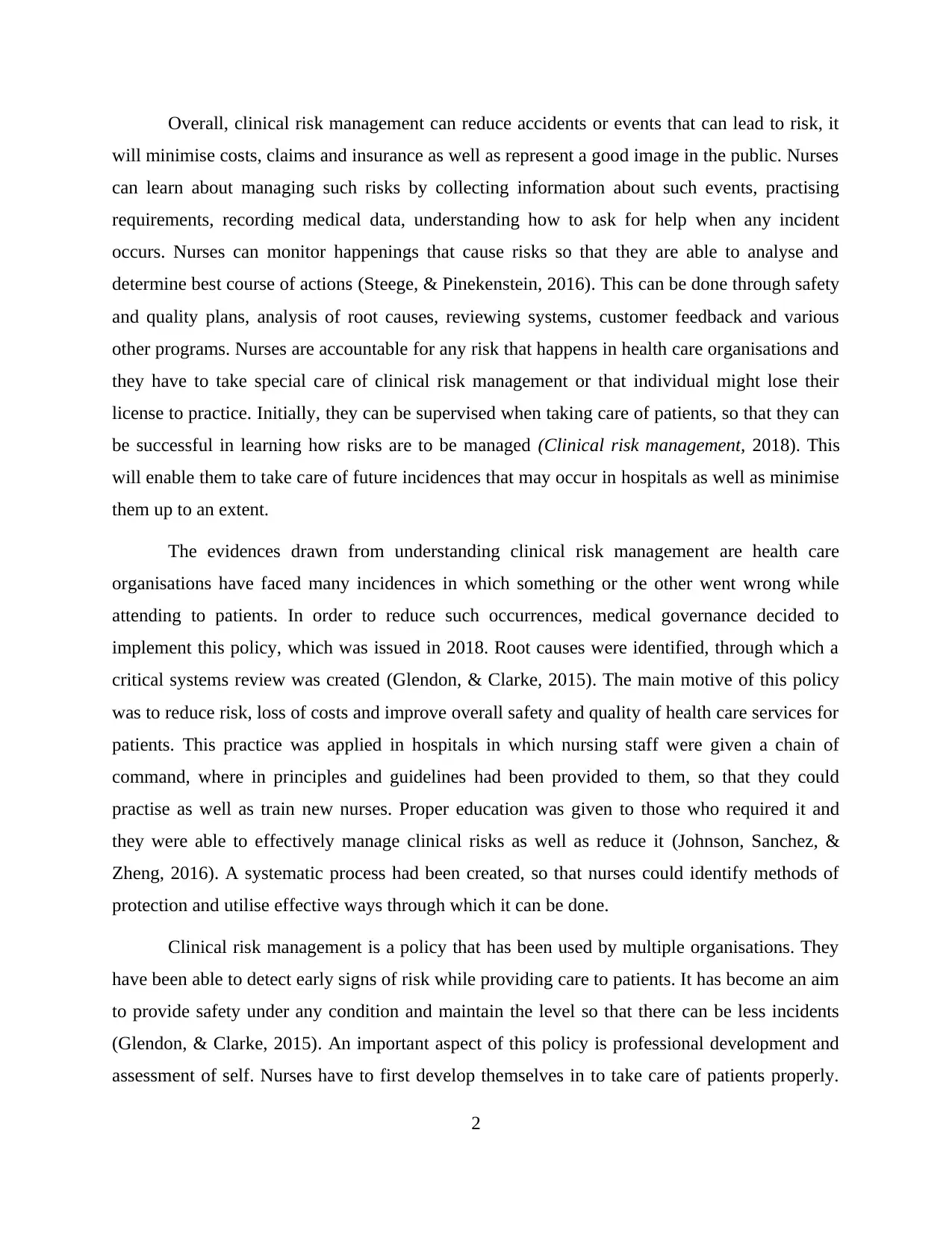
Overall, clinical risk management can reduce accidents or events that can lead to risk, it
will minimise costs, claims and insurance as well as represent a good image in the public. Nurses
can learn about managing such risks by collecting information about such events, practising
requirements, recording medical data, understanding how to ask for help when any incident
occurs. Nurses can monitor happenings that cause risks so that they are able to analyse and
determine best course of actions (Steege, & Pinekenstein, 2016). This can be done through safety
and quality plans, analysis of root causes, reviewing systems, customer feedback and various
other programs. Nurses are accountable for any risk that happens in health care organisations and
they have to take special care of clinical risk management or that individual might lose their
license to practice. Initially, they can be supervised when taking care of patients, so that they can
be successful in learning how risks are to be managed (Clinical risk management, 2018). This
will enable them to take care of future incidences that may occur in hospitals as well as minimise
them up to an extent.
The evidences drawn from understanding clinical risk management are health care
organisations have faced many incidences in which something or the other went wrong while
attending to patients. In order to reduce such occurrences, medical governance decided to
implement this policy, which was issued in 2018. Root causes were identified, through which a
critical systems review was created (Glendon, & Clarke, 2015). The main motive of this policy
was to reduce risk, loss of costs and improve overall safety and quality of health care services for
patients. This practice was applied in hospitals in which nursing staff were given a chain of
command, where in principles and guidelines had been provided to them, so that they could
practise as well as train new nurses. Proper education was given to those who required it and
they were able to effectively manage clinical risks as well as reduce it (Johnson, Sanchez, &
Zheng, 2016). A systematic process had been created, so that nurses could identify methods of
protection and utilise effective ways through which it can be done.
Clinical risk management is a policy that has been used by multiple organisations. They
have been able to detect early signs of risk while providing care to patients. It has become an aim
to provide safety under any condition and maintain the level so that there can be less incidents
(Glendon, & Clarke, 2015). An important aspect of this policy is professional development and
assessment of self. Nurses have to first develop themselves in to take care of patients properly.
2
will minimise costs, claims and insurance as well as represent a good image in the public. Nurses
can learn about managing such risks by collecting information about such events, practising
requirements, recording medical data, understanding how to ask for help when any incident
occurs. Nurses can monitor happenings that cause risks so that they are able to analyse and
determine best course of actions (Steege, & Pinekenstein, 2016). This can be done through safety
and quality plans, analysis of root causes, reviewing systems, customer feedback and various
other programs. Nurses are accountable for any risk that happens in health care organisations and
they have to take special care of clinical risk management or that individual might lose their
license to practice. Initially, they can be supervised when taking care of patients, so that they can
be successful in learning how risks are to be managed (Clinical risk management, 2018). This
will enable them to take care of future incidences that may occur in hospitals as well as minimise
them up to an extent.
The evidences drawn from understanding clinical risk management are health care
organisations have faced many incidences in which something or the other went wrong while
attending to patients. In order to reduce such occurrences, medical governance decided to
implement this policy, which was issued in 2018. Root causes were identified, through which a
critical systems review was created (Glendon, & Clarke, 2015). The main motive of this policy
was to reduce risk, loss of costs and improve overall safety and quality of health care services for
patients. This practice was applied in hospitals in which nursing staff were given a chain of
command, where in principles and guidelines had been provided to them, so that they could
practise as well as train new nurses. Proper education was given to those who required it and
they were able to effectively manage clinical risks as well as reduce it (Johnson, Sanchez, &
Zheng, 2016). A systematic process had been created, so that nurses could identify methods of
protection and utilise effective ways through which it can be done.
Clinical risk management is a policy that has been used by multiple organisations. They
have been able to detect early signs of risk while providing care to patients. It has become an aim
to provide safety under any condition and maintain the level so that there can be less incidents
(Glendon, & Clarke, 2015). An important aspect of this policy is professional development and
assessment of self. Nurses have to first develop themselves in to take care of patients properly.
2
Paraphrase This Document
Need a fresh take? Get an instant paraphrase of this document with our AI Paraphraser
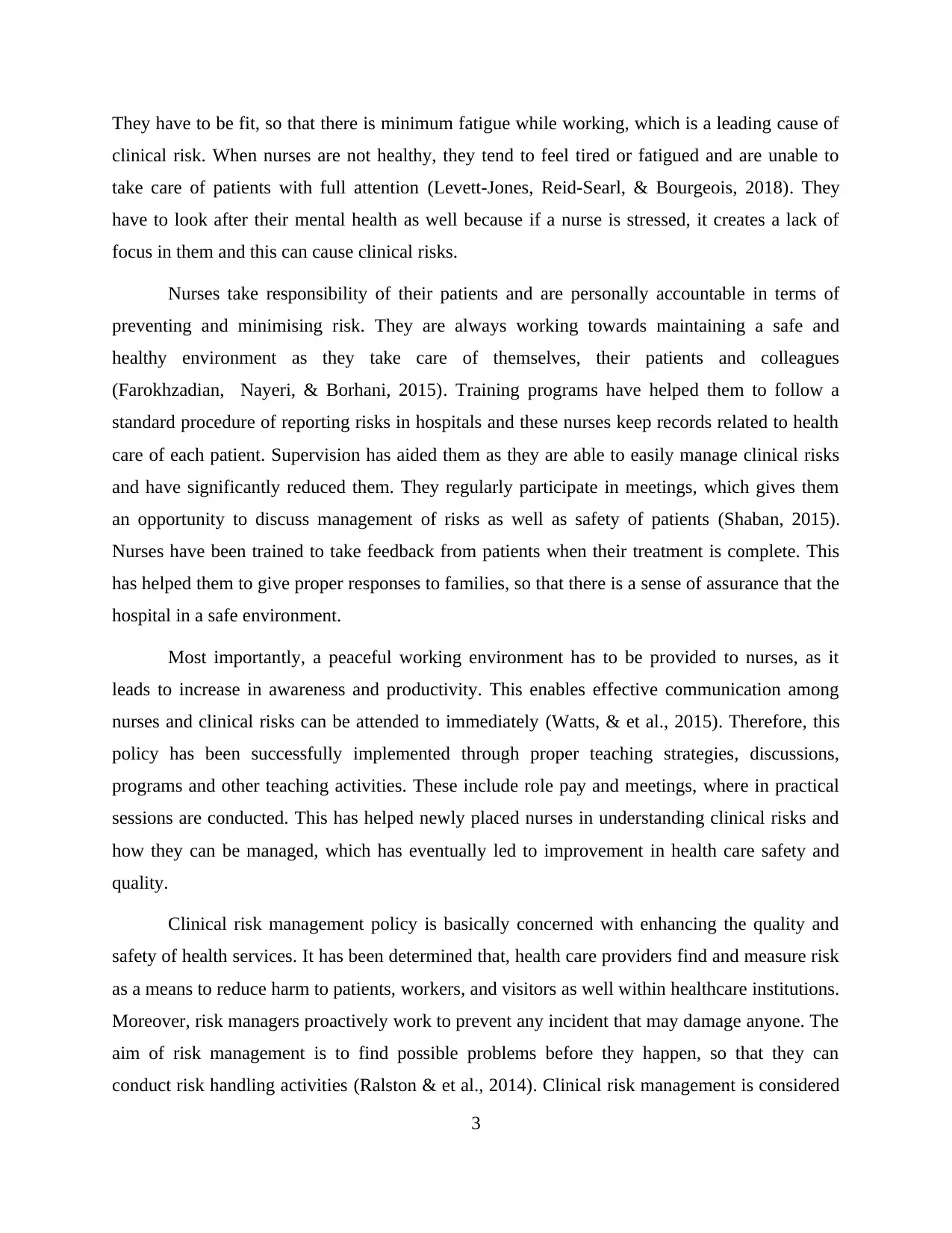
They have to be fit, so that there is minimum fatigue while working, which is a leading cause of
clinical risk. When nurses are not healthy, they tend to feel tired or fatigued and are unable to
take care of patients with full attention (Levett-Jones, Reid-Searl, & Bourgeois, 2018). They
have to look after their mental health as well because if a nurse is stressed, it creates a lack of
focus in them and this can cause clinical risks.
Nurses take responsibility of their patients and are personally accountable in terms of
preventing and minimising risk. They are always working towards maintaining a safe and
healthy environment as they take care of themselves, their patients and colleagues
(Farokhzadian, Nayeri, & Borhani, 2015). Training programs have helped them to follow a
standard procedure of reporting risks in hospitals and these nurses keep records related to health
care of each patient. Supervision has aided them as they are able to easily manage clinical risks
and have significantly reduced them. They regularly participate in meetings, which gives them
an opportunity to discuss management of risks as well as safety of patients (Shaban, 2015).
Nurses have been trained to take feedback from patients when their treatment is complete. This
has helped them to give proper responses to families, so that there is a sense of assurance that the
hospital in a safe environment.
Most importantly, a peaceful working environment has to be provided to nurses, as it
leads to increase in awareness and productivity. This enables effective communication among
nurses and clinical risks can be attended to immediately (Watts, & et al., 2015). Therefore, this
policy has been successfully implemented through proper teaching strategies, discussions,
programs and other teaching activities. These include role pay and meetings, where in practical
sessions are conducted. This has helped newly placed nurses in understanding clinical risks and
how they can be managed, which has eventually led to improvement in health care safety and
quality.
Clinical risk management policy is basically concerned with enhancing the quality and
safety of health services. It has been determined that, health care providers find and measure risk
as a means to reduce harm to patients, workers, and visitors as well within healthcare institutions.
Moreover, risk managers proactively work to prevent any incident that may damage anyone. The
aim of risk management is to find possible problems before they happen, so that they can
conduct risk handling activities (Ralston & et al., 2014). Clinical risk management is considered
3
clinical risk. When nurses are not healthy, they tend to feel tired or fatigued and are unable to
take care of patients with full attention (Levett-Jones, Reid-Searl, & Bourgeois, 2018). They
have to look after their mental health as well because if a nurse is stressed, it creates a lack of
focus in them and this can cause clinical risks.
Nurses take responsibility of their patients and are personally accountable in terms of
preventing and minimising risk. They are always working towards maintaining a safe and
healthy environment as they take care of themselves, their patients and colleagues
(Farokhzadian, Nayeri, & Borhani, 2015). Training programs have helped them to follow a
standard procedure of reporting risks in hospitals and these nurses keep records related to health
care of each patient. Supervision has aided them as they are able to easily manage clinical risks
and have significantly reduced them. They regularly participate in meetings, which gives them
an opportunity to discuss management of risks as well as safety of patients (Shaban, 2015).
Nurses have been trained to take feedback from patients when their treatment is complete. This
has helped them to give proper responses to families, so that there is a sense of assurance that the
hospital in a safe environment.
Most importantly, a peaceful working environment has to be provided to nurses, as it
leads to increase in awareness and productivity. This enables effective communication among
nurses and clinical risks can be attended to immediately (Watts, & et al., 2015). Therefore, this
policy has been successfully implemented through proper teaching strategies, discussions,
programs and other teaching activities. These include role pay and meetings, where in practical
sessions are conducted. This has helped newly placed nurses in understanding clinical risks and
how they can be managed, which has eventually led to improvement in health care safety and
quality.
Clinical risk management policy is basically concerned with enhancing the quality and
safety of health services. It has been determined that, health care providers find and measure risk
as a means to reduce harm to patients, workers, and visitors as well within healthcare institutions.
Moreover, risk managers proactively work to prevent any incident that may damage anyone. The
aim of risk management is to find possible problems before they happen, so that they can
conduct risk handling activities (Ralston & et al., 2014). Clinical risk management is considered
3
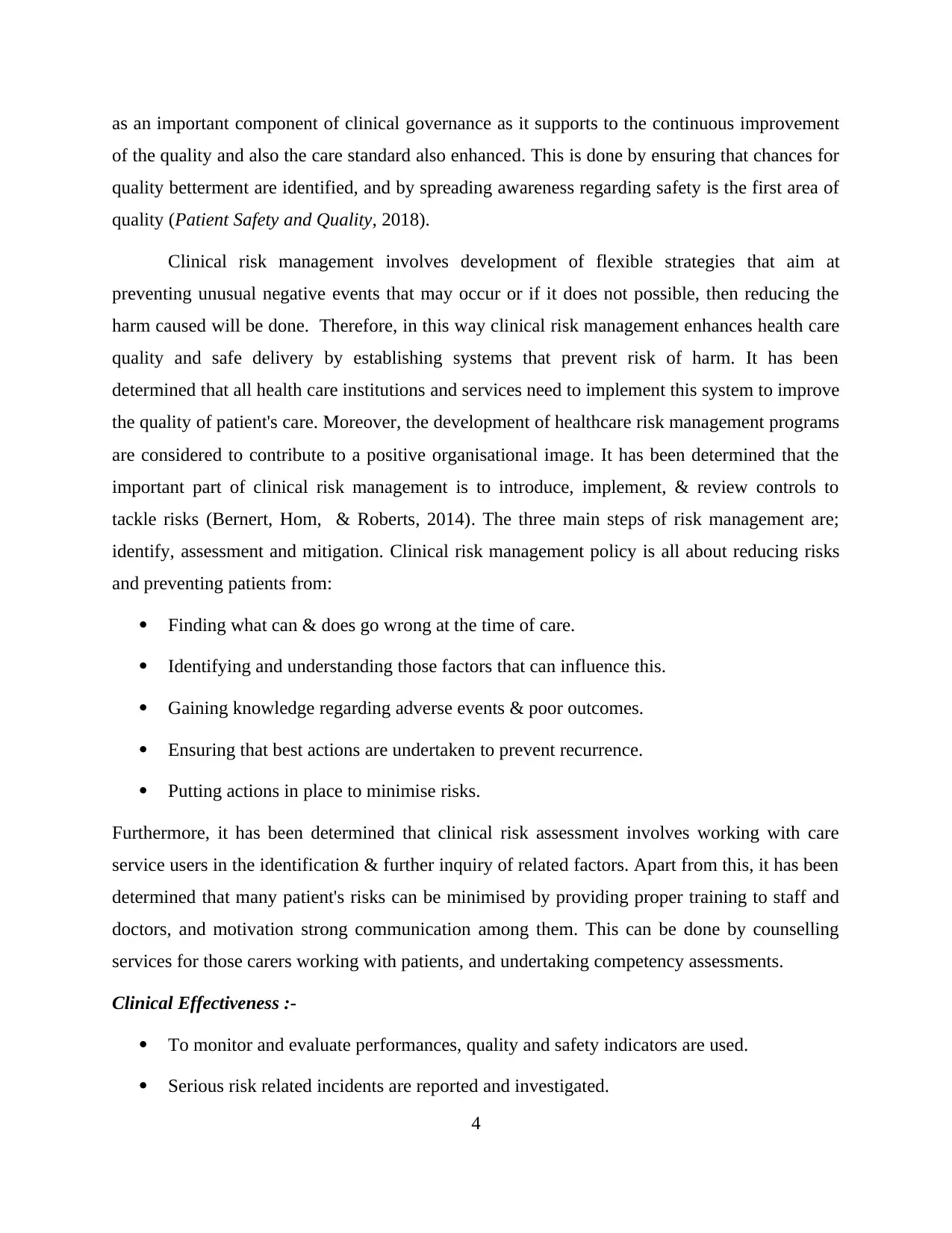
as an important component of clinical governance as it supports to the continuous improvement
of the quality and also the care standard also enhanced. This is done by ensuring that chances for
quality betterment are identified, and by spreading awareness regarding safety is the first area of
quality (Patient Safety and Quality, 2018).
Clinical risk management involves development of flexible strategies that aim at
preventing unusual negative events that may occur or if it does not possible, then reducing the
harm caused will be done. Therefore, in this way clinical risk management enhances health care
quality and safe delivery by establishing systems that prevent risk of harm. It has been
determined that all health care institutions and services need to implement this system to improve
the quality of patient's care. Moreover, the development of healthcare risk management programs
are considered to contribute to a positive organisational image. It has been determined that the
important part of clinical risk management is to introduce, implement, & review controls to
tackle risks (Bernert, Hom, & Roberts, 2014). The three main steps of risk management are;
identify, assessment and mitigation. Clinical risk management policy is all about reducing risks
and preventing patients from:
Finding what can & does go wrong at the time of care.
Identifying and understanding those factors that can influence this.
Gaining knowledge regarding adverse events & poor outcomes.
Ensuring that best actions are undertaken to prevent recurrence.
Putting actions in place to minimise risks.
Furthermore, it has been determined that clinical risk assessment involves working with care
service users in the identification & further inquiry of related factors. Apart from this, it has been
determined that many patient's risks can be minimised by providing proper training to staff and
doctors, and motivation strong communication among them. This can be done by counselling
services for those carers working with patients, and undertaking competency assessments.
Clinical Effectiveness :-
To monitor and evaluate performances, quality and safety indicators are used.
Serious risk related incidents are reported and investigated.
4
of the quality and also the care standard also enhanced. This is done by ensuring that chances for
quality betterment are identified, and by spreading awareness regarding safety is the first area of
quality (Patient Safety and Quality, 2018).
Clinical risk management involves development of flexible strategies that aim at
preventing unusual negative events that may occur or if it does not possible, then reducing the
harm caused will be done. Therefore, in this way clinical risk management enhances health care
quality and safe delivery by establishing systems that prevent risk of harm. It has been
determined that all health care institutions and services need to implement this system to improve
the quality of patient's care. Moreover, the development of healthcare risk management programs
are considered to contribute to a positive organisational image. It has been determined that the
important part of clinical risk management is to introduce, implement, & review controls to
tackle risks (Bernert, Hom, & Roberts, 2014). The three main steps of risk management are;
identify, assessment and mitigation. Clinical risk management policy is all about reducing risks
and preventing patients from:
Finding what can & does go wrong at the time of care.
Identifying and understanding those factors that can influence this.
Gaining knowledge regarding adverse events & poor outcomes.
Ensuring that best actions are undertaken to prevent recurrence.
Putting actions in place to minimise risks.
Furthermore, it has been determined that clinical risk assessment involves working with care
service users in the identification & further inquiry of related factors. Apart from this, it has been
determined that many patient's risks can be minimised by providing proper training to staff and
doctors, and motivation strong communication among them. This can be done by counselling
services for those carers working with patients, and undertaking competency assessments.
Clinical Effectiveness :-
To monitor and evaluate performances, quality and safety indicators are used.
Serious risk related incidents are reported and investigated.
4
⊘ This is a preview!⊘
Do you want full access?
Subscribe today to unlock all pages.

Trusted by 1+ million students worldwide
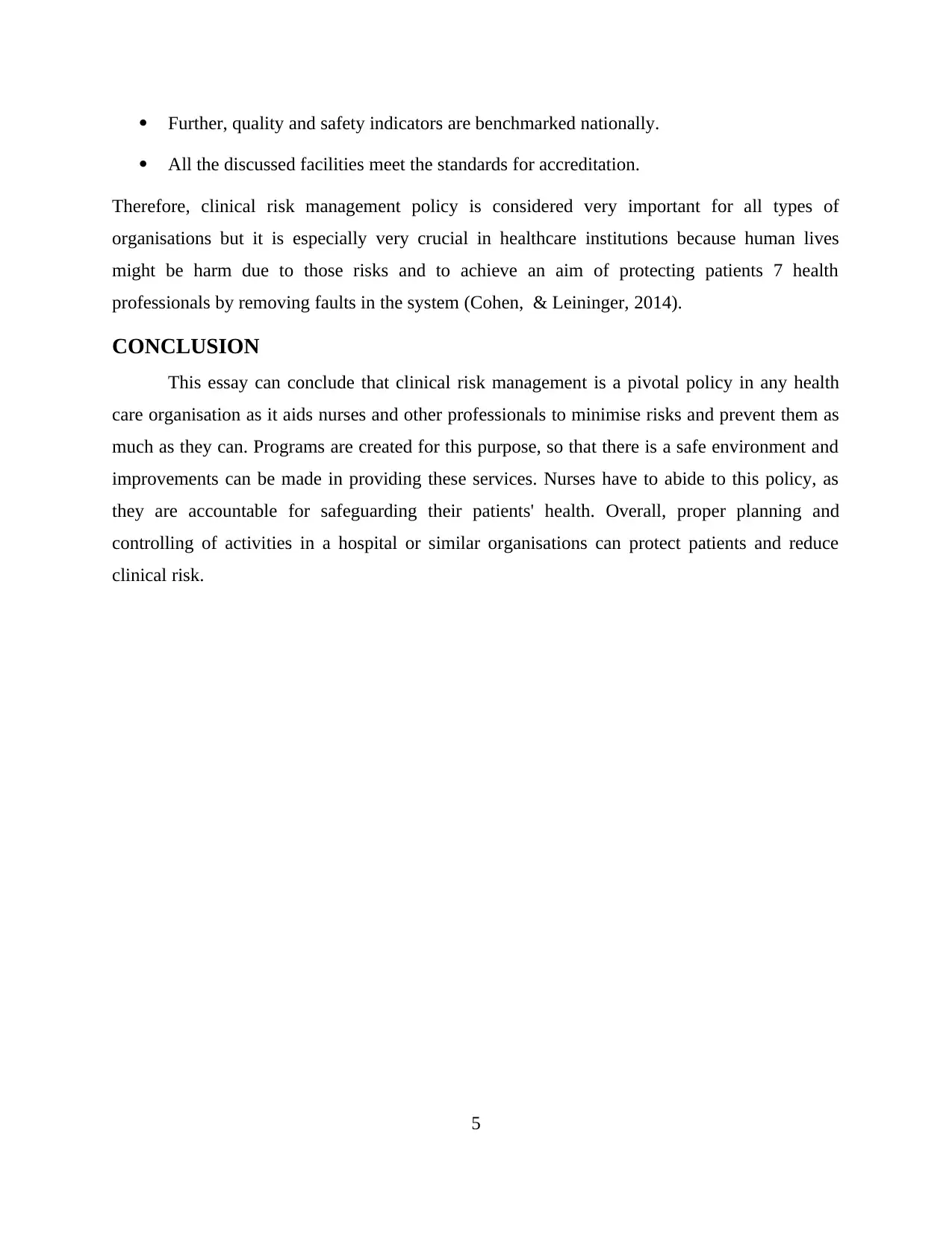
Further, quality and safety indicators are benchmarked nationally.
All the discussed facilities meet the standards for accreditation.
Therefore, clinical risk management policy is considered very important for all types of
organisations but it is especially very crucial in healthcare institutions because human lives
might be harm due to those risks and to achieve an aim of protecting patients 7 health
professionals by removing faults in the system (Cohen, & Leininger, 2014).
CONCLUSION
This essay can conclude that clinical risk management is a pivotal policy in any health
care organisation as it aids nurses and other professionals to minimise risks and prevent them as
much as they can. Programs are created for this purpose, so that there is a safe environment and
improvements can be made in providing these services. Nurses have to abide to this policy, as
they are accountable for safeguarding their patients' health. Overall, proper planning and
controlling of activities in a hospital or similar organisations can protect patients and reduce
clinical risk.
5
All the discussed facilities meet the standards for accreditation.
Therefore, clinical risk management policy is considered very important for all types of
organisations but it is especially very crucial in healthcare institutions because human lives
might be harm due to those risks and to achieve an aim of protecting patients 7 health
professionals by removing faults in the system (Cohen, & Leininger, 2014).
CONCLUSION
This essay can conclude that clinical risk management is a pivotal policy in any health
care organisation as it aids nurses and other professionals to minimise risks and prevent them as
much as they can. Programs are created for this purpose, so that there is a safe environment and
improvements can be made in providing these services. Nurses have to abide to this policy, as
they are accountable for safeguarding their patients' health. Overall, proper planning and
controlling of activities in a hospital or similar organisations can protect patients and reduce
clinical risk.
5
Paraphrase This Document
Need a fresh take? Get an instant paraphrase of this document with our AI Paraphraser
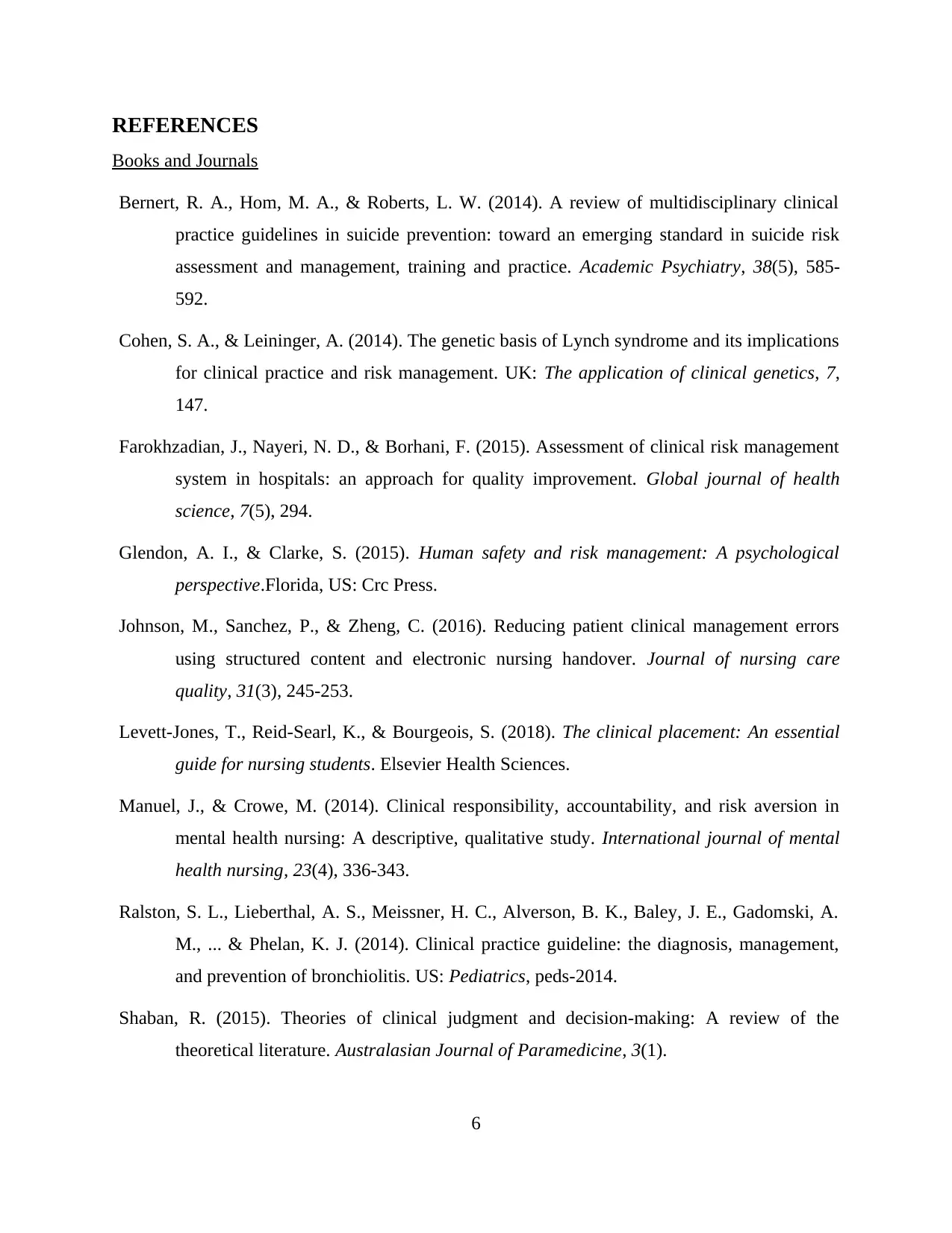
REFERENCES
Books and Journals
Bernert, R. A., Hom, M. A., & Roberts, L. W. (2014). A review of multidisciplinary clinical
practice guidelines in suicide prevention: toward an emerging standard in suicide risk
assessment and management, training and practice. Academic Psychiatry, 38(5), 585-
592.
Cohen, S. A., & Leininger, A. (2014). The genetic basis of Lynch syndrome and its implications
for clinical practice and risk management. UK: The application of clinical genetics, 7,
147.
Farokhzadian, J., Nayeri, N. D., & Borhani, F. (2015). Assessment of clinical risk management
system in hospitals: an approach for quality improvement. Global journal of health
science, 7(5), 294.
Glendon, A. I., & Clarke, S. (2015). Human safety and risk management: A psychological
perspective.Florida, US: Crc Press.
Johnson, M., Sanchez, P., & Zheng, C. (2016). Reducing patient clinical management errors
using structured content and electronic nursing handover. Journal of nursing care
quality, 31(3), 245-253.
Levett-Jones, T., Reid-Searl, K., & Bourgeois, S. (2018). The clinical placement: An essential
guide for nursing students. Elsevier Health Sciences.
Manuel, J., & Crowe, M. (2014). Clinical responsibility, accountability, and risk aversion in
mental health nursing: A descriptive, qualitative study. International journal of mental
health nursing, 23(4), 336-343.
Ralston, S. L., Lieberthal, A. S., Meissner, H. C., Alverson, B. K., Baley, J. E., Gadomski, A.
M., ... & Phelan, K. J. (2014). Clinical practice guideline: the diagnosis, management,
and prevention of bronchiolitis. US: Pediatrics, peds-2014.
Shaban, R. (2015). Theories of clinical judgment and decision-making: A review of the
theoretical literature. Australasian Journal of Paramedicine, 3(1).
6
Books and Journals
Bernert, R. A., Hom, M. A., & Roberts, L. W. (2014). A review of multidisciplinary clinical
practice guidelines in suicide prevention: toward an emerging standard in suicide risk
assessment and management, training and practice. Academic Psychiatry, 38(5), 585-
592.
Cohen, S. A., & Leininger, A. (2014). The genetic basis of Lynch syndrome and its implications
for clinical practice and risk management. UK: The application of clinical genetics, 7,
147.
Farokhzadian, J., Nayeri, N. D., & Borhani, F. (2015). Assessment of clinical risk management
system in hospitals: an approach for quality improvement. Global journal of health
science, 7(5), 294.
Glendon, A. I., & Clarke, S. (2015). Human safety and risk management: A psychological
perspective.Florida, US: Crc Press.
Johnson, M., Sanchez, P., & Zheng, C. (2016). Reducing patient clinical management errors
using structured content and electronic nursing handover. Journal of nursing care
quality, 31(3), 245-253.
Levett-Jones, T., Reid-Searl, K., & Bourgeois, S. (2018). The clinical placement: An essential
guide for nursing students. Elsevier Health Sciences.
Manuel, J., & Crowe, M. (2014). Clinical responsibility, accountability, and risk aversion in
mental health nursing: A descriptive, qualitative study. International journal of mental
health nursing, 23(4), 336-343.
Ralston, S. L., Lieberthal, A. S., Meissner, H. C., Alverson, B. K., Baley, J. E., Gadomski, A.
M., ... & Phelan, K. J. (2014). Clinical practice guideline: the diagnosis, management,
and prevention of bronchiolitis. US: Pediatrics, peds-2014.
Shaban, R. (2015). Theories of clinical judgment and decision-making: A review of the
theoretical literature. Australasian Journal of Paramedicine, 3(1).
6
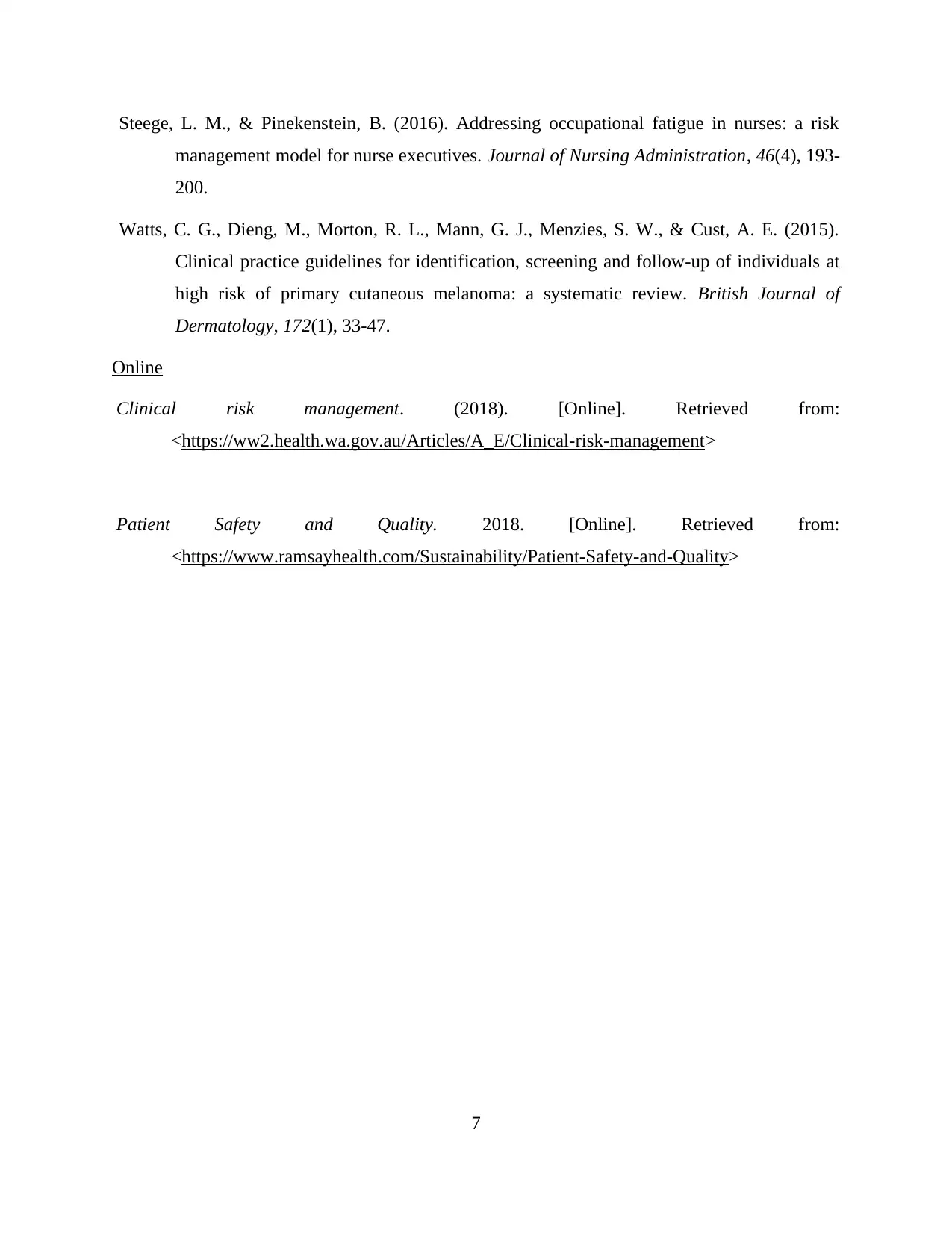
Steege, L. M., & Pinekenstein, B. (2016). Addressing occupational fatigue in nurses: a risk
management model for nurse executives. Journal of Nursing Administration, 46(4), 193-
200.
Watts, C. G., Dieng, M., Morton, R. L., Mann, G. J., Menzies, S. W., & Cust, A. E. (2015).
Clinical practice guidelines for identification, screening and follow‐up of individuals at
high risk of primary cutaneous melanoma: a systematic review. British Journal of
Dermatology, 172(1), 33-47.
Online
Clinical risk management. (2018). [Online]. Retrieved from:
<https://ww2.health.wa.gov.au/Articles/A_E/Clinical-risk-management>
Patient Safety and Quality. 2018. [Online]. Retrieved from:
<https://www.ramsayhealth.com/Sustainability/Patient-Safety-and-Quality>
7
management model for nurse executives. Journal of Nursing Administration, 46(4), 193-
200.
Watts, C. G., Dieng, M., Morton, R. L., Mann, G. J., Menzies, S. W., & Cust, A. E. (2015).
Clinical practice guidelines for identification, screening and follow‐up of individuals at
high risk of primary cutaneous melanoma: a systematic review. British Journal of
Dermatology, 172(1), 33-47.
Online
Clinical risk management. (2018). [Online]. Retrieved from:
<https://ww2.health.wa.gov.au/Articles/A_E/Clinical-risk-management>
Patient Safety and Quality. 2018. [Online]. Retrieved from:
<https://www.ramsayhealth.com/Sustainability/Patient-Safety-and-Quality>
7
⊘ This is a preview!⊘
Do you want full access?
Subscribe today to unlock all pages.

Trusted by 1+ million students worldwide
1 out of 9
Related Documents
Your All-in-One AI-Powered Toolkit for Academic Success.
+13062052269
info@desklib.com
Available 24*7 on WhatsApp / Email
![[object Object]](/_next/static/media/star-bottom.7253800d.svg)
Unlock your academic potential
Copyright © 2020–2025 A2Z Services. All Rights Reserved. Developed and managed by ZUCOL.





